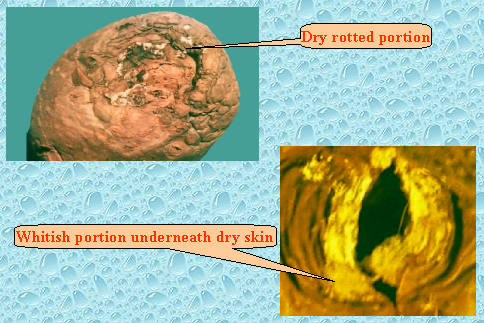

In
black leg phase, the disease develops from infected seed tuber, causes haulm and
vascular browning. Tissues in lesions become shrivelled and
plants become yellow and die quickly. All the three Erwinias causes soft rot of
tuber. Black leg disease due to E.
carotovora ssp. atroseptica occurs below 250 C whereas ssp. chrysanthemi
at higher temperatures. Stem and petiole rot or top rot due to E.
carotovora. ssp. carotovora occurs as water soaked lesion and later as strips in
succulent parts of stem and petiole and the affected parts rot leading to
toppling of stem and has been reported mainly from Indian plains and also from
hills. B. polymyxa is reported to
cause initial water soaking in ventral veins and later cause necrosis.
Apical buds become bunchy and stunted and unfolding of leaves is also
delayed.
In
tuber, soft rot organisms cause water soaking around lenticels or at the heel
end. Under humid conditions rot develops very fast, secondary organism(s) invade
and the tuber becomes soft and then decays.
Decaying tissues become slimy and emits foul smell. A brown liquid oozes
out from the decayed tubers thus spreading the infection to the neighbouring
tubers.
The bacteria are present in soil, water and tubers. Soft rot bacteria like Erwinias in potato tuber are carried deeply in intercellular places, in lenticels, and wounds therefore are difficult to eradicate. These quiescent bacteria proliferate under high moisture conditions and require a water film that cause anaerobic conditions leading to disease development. Injury is a must for the bacterial infection to occur.